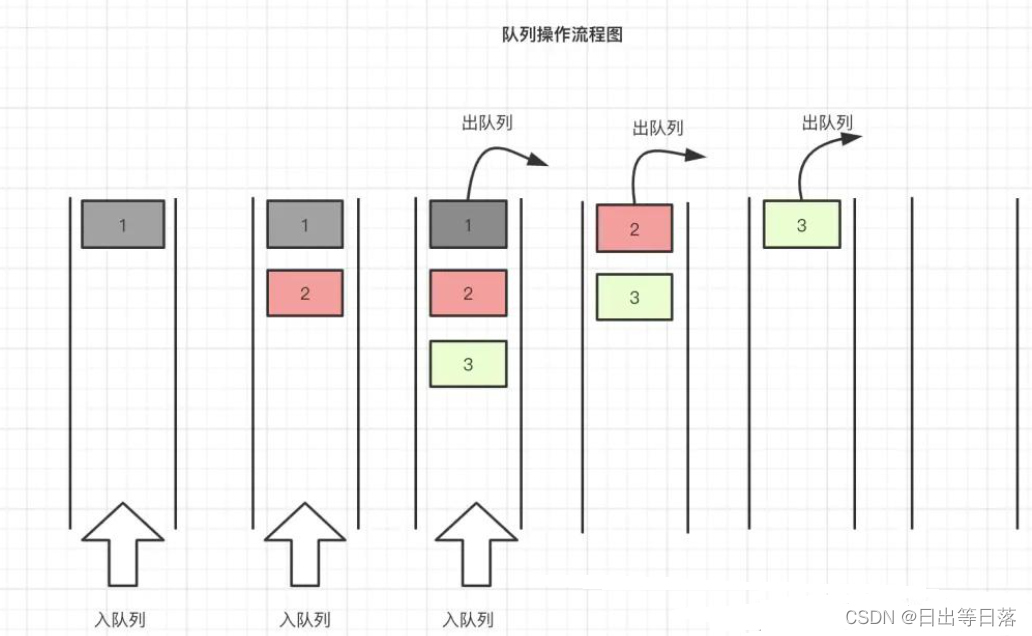您现在的位置是:首页 >学无止境 >【数据结构】队列的实现网站首页学无止境
【数据结构】队列的实现
简介【数据结构】队列的实现
😛作者:日出等日落
📘 专栏:数据结构
时间一直在流逝,貌似所有人都在向前走,只有我一直在原地踏步,说着要向前看要向前看,可总感觉没有完全放开步子大步向前走,2022我们来一次告别仪式吧,告别所有的不好,迎来崭新的2023,已然找不到坚持下去的理由,那就找一个重新开始的理由吧。
目录
队列 :
队列的概念及结构:
队列:只允许在一端进行插入数据操作,在另一端进行删除数据操作的特殊线性表,队列具有先进先出 FIFO(First In First Out)
入队列:进行插入操作的一端称为队尾
出队列:进行删除操作的一端称为队头

队列的各功能实现:
队列也可以数组和链表的结构实现,使用链表的结构实现更优一些,因为如果使用数组的结构,出队列在数组头上出数据,效率会比较低。
结构体:
// 链式结构:表示队列
typedef struct QueueNode
{
QDataType data;
struct Queue* next;
}Qnode;
// 队列的结构
typedef struct Queue
{
Qnode* head;
Qnode* tail;
int size;
}Queue;QueueInit(初始化队列):
// 初始化队列
void QueueInit(Queue* pq)
{
assert(pq);
pq->head = NULL;
pq->tail = NULL;
pq->size = 0;
}QueueDestroy(销毁队列):
// 销毁队列
void QueueDestroy(Queue* pq)
{
assert(pq);
Qnode* cur = pq->head;
while (cur)
{
Qnode* del = cur;
cur = cur->next;
free(del);
del = NULL;
}
pq->head = pq->tail = NULL;
pq->size = 0;
}QueuePush(队尾入队列):
// 队尾入队列
void QueuePush(Queue* pq, QDataType x)
{
assert(pq);
Qnode* newnode = (Qnode*)malloc(sizeof(Qnode));
if (newnode == NULL)
{
perror("malloc: fail");
exit(-1);
}
else
{
newnode->data = x;
newnode->next = NULL;
}
if (pq->tail == NULL)
{
pq->head = pq->tail = newnode;
}
else
{
pq->tail->next = newnode;
pq->tail = newnode;
}
pq->size++;
}
QueuePop(队头出队列):
// 队头出队列
void QueuePop(Queue* pq)
{
assert(pq);
assert(!QueueEmpty(pq));
if (pq->head->next == NULL)
{
free(pq->head);
pq->head = pq->tail = NULL;
}
else
{
Qnode* del = pq->head;
pq->head = pq->head->next;
free(del);
}
pq->size--;
}QueueFront(获取队列头部元素):
// 获取队列头部元素
QDataType QueueFront(Queue* pq)
{
assert(pq);
assert(!QueueEmpty(pq));
return pq->head->data;
}QueueBack(获取队列队尾元素):
// 获取队列队尾元素
QDataType QueueBack(Queue* pq)
{
assert(pq);
assert(!QueueEmpty(pq));
return pq->tail->data;
}QueueEmpty(检测队列是否为空):
// 检测队列是否为空,如果为空返回非零结果,如果非空返回0
bool QueueEmpty(Queue* pq)
{
assert(pq);
return pq->head == NULL && pq->tail == NULL;
}QueueSize(返回队列大小):
//返回队列大小
int QueueSize(Queue* pq)
{
assert(pq);
return pq->size;
}完整代码:
Queue.h:
#pragma once
#include <stdio.h>
#include <assert.h>
#include <stdlib.h>
#include <stdbool.h>
typedef int QDataType;
// 链式结构:表示队列
typedef struct QueueNode
{
QDataType data;
struct Queue* next;
}Qnode;
// 队列的结构
typedef struct Queue
{
Qnode* head;
Qnode* tail;
int size;
}Queue;
// 初始化队列
void QueueInit(Queue* pq);
// 销毁队列
void QueueDestroy(Queue* pq);
// 队尾入队列
void QueuePush(Queue* pq, QDataType x);
// 队头出队列
void QueuePop(Queue* pq);
// 获取队列头部元素
QDataType QueueFront(Queue* pq);
// 获取队列队尾元素
QDataType QueueBack(Queue* pq);
// 检测队列是否为空,如果为空返回非零结果,如果非空返回0
bool QueueEmpty(Queue* pq);
//返回队列大小
int QueueSize(Queue* pq);
Queue.c:
#define _CRT_SECURE_NO_WARNINGS 1
#include "Queue.h"
// 初始化队列
void QueueInit(Queue* pq)
{
assert(pq);
pq->head = NULL;
pq->tail = NULL;
pq->size = 0;
}
// 销毁队列
void QueueDestroy(Queue* pq)
{
assert(pq);
Qnode* cur = pq->head;
while (cur)
{
Qnode* del = cur;
cur = cur->next;
free(del);
del = NULL;
}
pq->head = pq->tail = NULL;
pq->size = 0;
}
// 队尾入队列
void QueuePush(Queue* pq, QDataType x)
{
assert(pq);
Qnode* newnode = (Qnode*)malloc(sizeof(Qnode));
if (newnode == NULL)
{
perror("malloc: fail");
exit(-1);
}
else
{
newnode->data = x;
newnode->next = NULL;
}
if (pq->tail == NULL)
{
pq->head = pq->tail = newnode;
}
else
{
pq->tail->next = newnode;
pq->tail = newnode;
}
pq->size++;
}
// 队头出队列
void QueuePop(Queue* pq)
{
assert(pq);
assert(!QueueEmpty(pq));
if (pq->head->next == NULL)
{
free(pq->head);
pq->head = pq->tail = NULL;
}
else
{
Qnode* del = pq->head;
pq->head = pq->head->next;
free(del);
}
pq->size--;
}
// 获取队列头部元素
QDataType QueueFront(Queue* pq)
{
assert(pq);
assert(!QueueEmpty(pq));
return pq->head->data;
}
// 获取队列队尾元素
QDataType QueueBack(Queue* pq)
{
assert(pq);
assert(!QueueEmpty(pq));
return pq->tail->data;
}
// 检测队列是否为空,如果为空返回非零结果,如果非空返回0
bool QueueEmpty(Queue* pq)
{
assert(pq);
return pq->head == NULL && pq->tail == NULL;
}
//返回队列大小
int QueueSize(Queue* pq)
{
assert(pq);
return pq->size;
}
Text.c:
#define _CRT_SECURE_NO_WARNINGS 1
#include "Queue.h"
void TestQueue()
{
//Queue q1;
//Queue q2;
//QueueInit(&q1);
//QueueInit(&q2);
//QueueDestroy(&q1);
//QueueDestroy(&q2);
Queue q;
QueueInit(&q);
QueuePush(&q, 1);
QueuePush(&q, 2);
QueuePush(&q, 3);
QueuePush(&q, 4);
printf("%d
", QueueSize(&q));
printf("%d
", QueueEmpty(&q));
printf("%d
", QueueFront(&q));
printf("%d
", QueueBack(&q));
while (!QueueEmpty(&q))
{
printf("%d ", QueueFront(&q));
QueuePop(&q);
}
printf("
");
printf("%d
", QueueSize(&q));
printf("%d
", QueueEmpty(&q));
//printf("%d
", QueueFront(&q));
//printf("%d
", QueueBack(&q));
QueueDestroy(&q);
}
int main()
{
TestQueue();
return 0;
}风语者!平时喜欢研究各种技术,目前在从事后端开发工作,热爱生活、热爱工作。







 U8W/U8W-Mini使用与常见问题解决
U8W/U8W-Mini使用与常见问题解决 QT多线程的5种用法,通过使用线程解决UI主界面的耗时操作代码,防止界面卡死。...
QT多线程的5种用法,通过使用线程解决UI主界面的耗时操作代码,防止界面卡死。... stm32使用HAL库配置串口中断收发数据(保姆级教程)
stm32使用HAL库配置串口中断收发数据(保姆级教程) 分享几个国内免费的ChatGPT镜像网址(亲测有效)
分享几个国内免费的ChatGPT镜像网址(亲测有效) SpringSecurity实现前后端分离认证授权
SpringSecurity实现前后端分离认证授权